MARIANI’SVirtual
Gourmet
May
11, 2014
NEWSLETTER
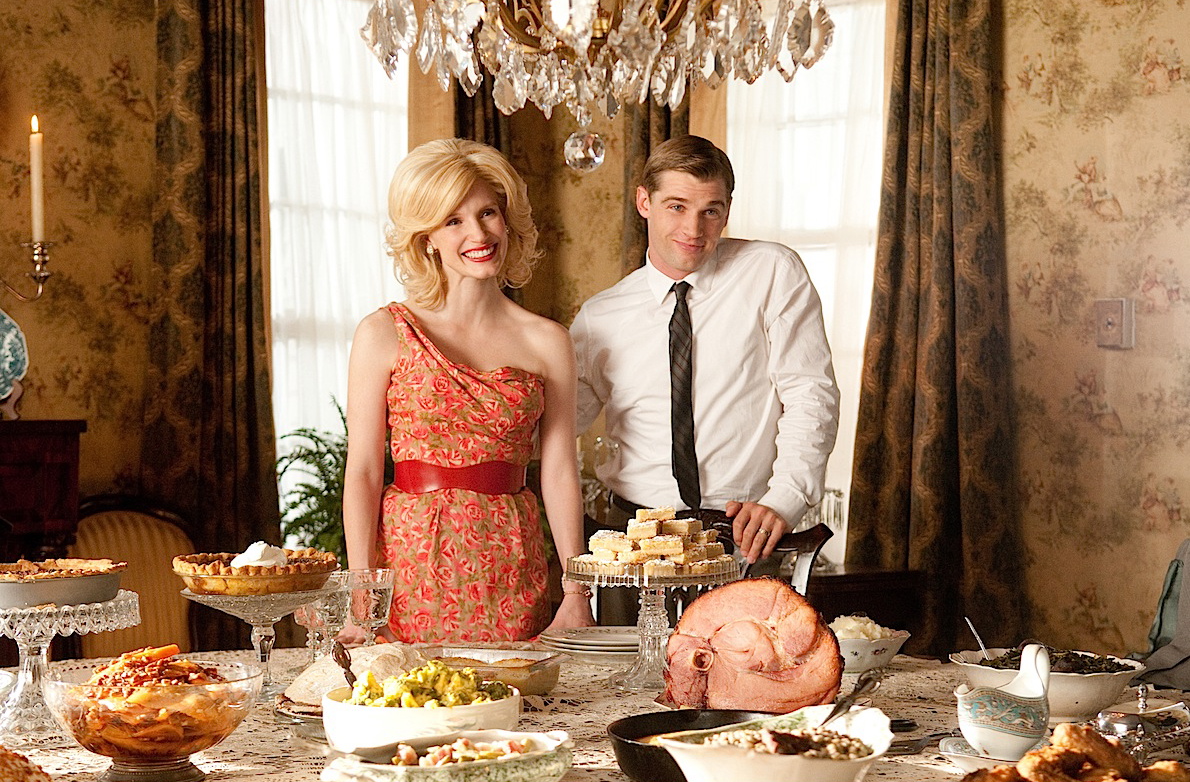
HAPPY MOTHER'S DAY!
❖❖❖
ANNOUNCEMENT
Beginning
May 27th, for five consecutive weeks on Tuesdays,
John Mariani will be teaching a seminar class in
"Food Writing" at Sarah Lawrence College in
Bronxville, NY. It is open to the general
public. For details contact: Center for
Continuing Education & Special Programs, Sarah
Lawrence College,1 Mead Way, Bronxville, NY
10708;Telephone: 914-395-2205; http://www.slc.edu/ce/cce/index.html
❖❖❖
IN THIS ISSUE
NEW RESTAURANTS OF DALLAS
by John Mariani
NEW YORK CORNER
RÔTISSERIE GEORGETTE
by John Mariani
NOTES FROM THE WINE CELLAR
SOUTH AFRICAN WINERIES GO HEAD TO HEAD
WITH OTHER NEW WORLD PRODUCERS
By John Mariani
❖❖❖
NEW RESTAURANTS OF DALLAS
by John Mariani

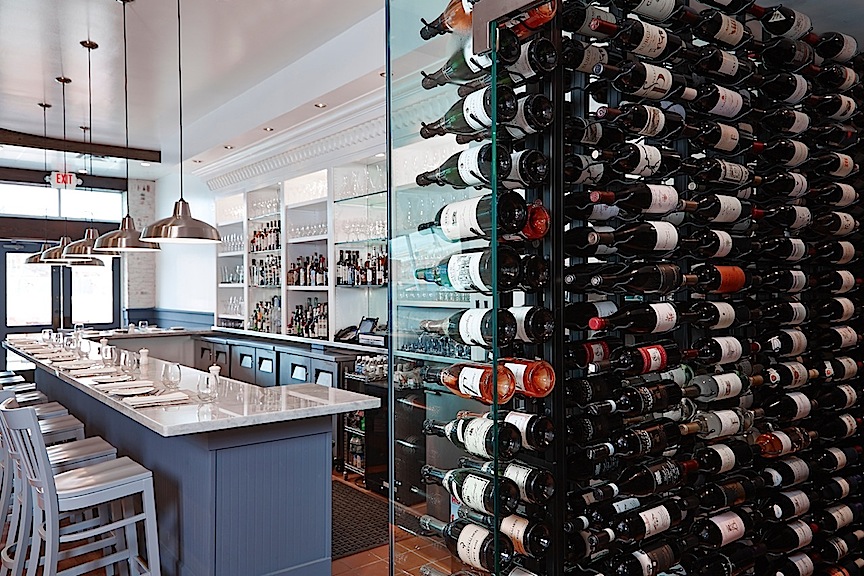 GEMMA
GEMMA
2323 North
Henderson Avenue
214-370-9426
gemmadallas.com
Photos
by Marple
Lovable is the word that immediately
came to mind as I entered this slightly out of the
way new restaurant in the Lower Greenwood
neighborhood that needs just such a place. Husband
and wife team Stephen Rogers and Allison Yoder
relocated here from Napa Valley where they’d spent
several years working at the highly regarded
restaurant Press, then it seemed time for
Dallas-bred Rogers to head home and show him what
he’d learned.
Allison would be the gregarious face in the
dining room.
This is one of the least
pretentious or overworked 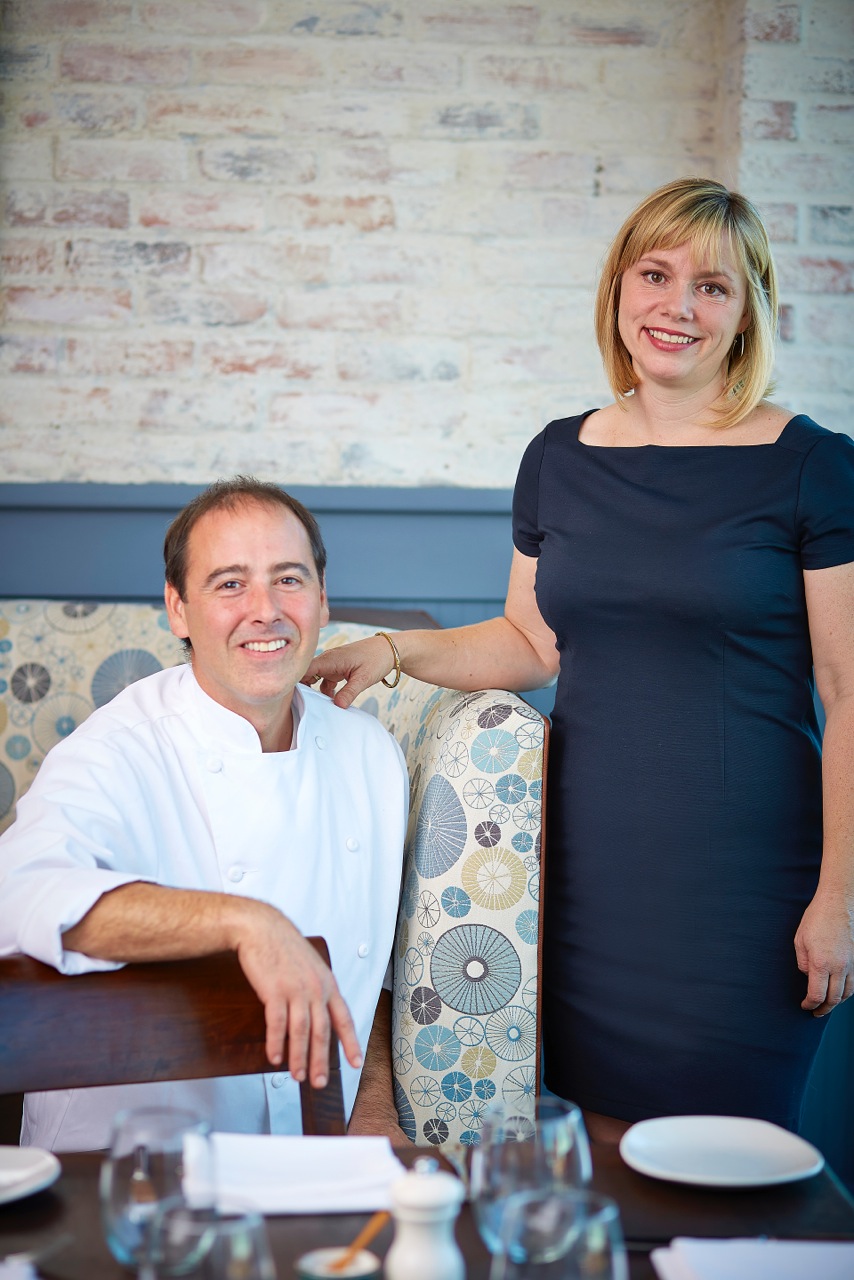 new
restaurants in the city, cozy, homelike, and, for
once, without a crippling noise level. The clean
white and Dutch blue colors lighted by hanging lamps
play well off the marble counter and glass wine
case. The
staff couldn’t be more affable, and the menu is
precisely the length a small operation like this
should have: a slew of appetizers that range from
raw seafood and beef tartare ($14-$16.50)—both very
good—to half a dozen vegetable options that include
herbed French fries ($5.25) that go fast at every
table. Crispy
sweetbreads are served simply with whole grain
mustard and a refreshing frisée salad
($12.50), and one of the most pleasing items is a
butter lettuce salad with a red wine vinaigrette and
pecorino romano cheese ($8.75).
new
restaurants in the city, cozy, homelike, and, for
once, without a crippling noise level. The clean
white and Dutch blue colors lighted by hanging lamps
play well off the marble counter and glass wine
case. The
staff couldn’t be more affable, and the menu is
precisely the length a small operation like this
should have: a slew of appetizers that range from
raw seafood and beef tartare ($14-$16.50)—both very
good—to half a dozen vegetable options that include
herbed French fries ($5.25) that go fast at every
table. Crispy
sweetbreads are served simply with whole grain
mustard and a refreshing frisée salad
($12.50), and one of the most pleasing items is a
butter lettuce salad with a red wine vinaigrette and
pecorino romano cheese ($8.75).
Everyone these days is serving
pasta on their menus, often with no notion of what a
good pasta dish is, so I was impressed and delighted
with pappardelle
with rich lamb shoulder, king trumpet mushroom
ragù with diced asparagus and lemon thyme
($25.95). I’d
already heard from several people that I just had to
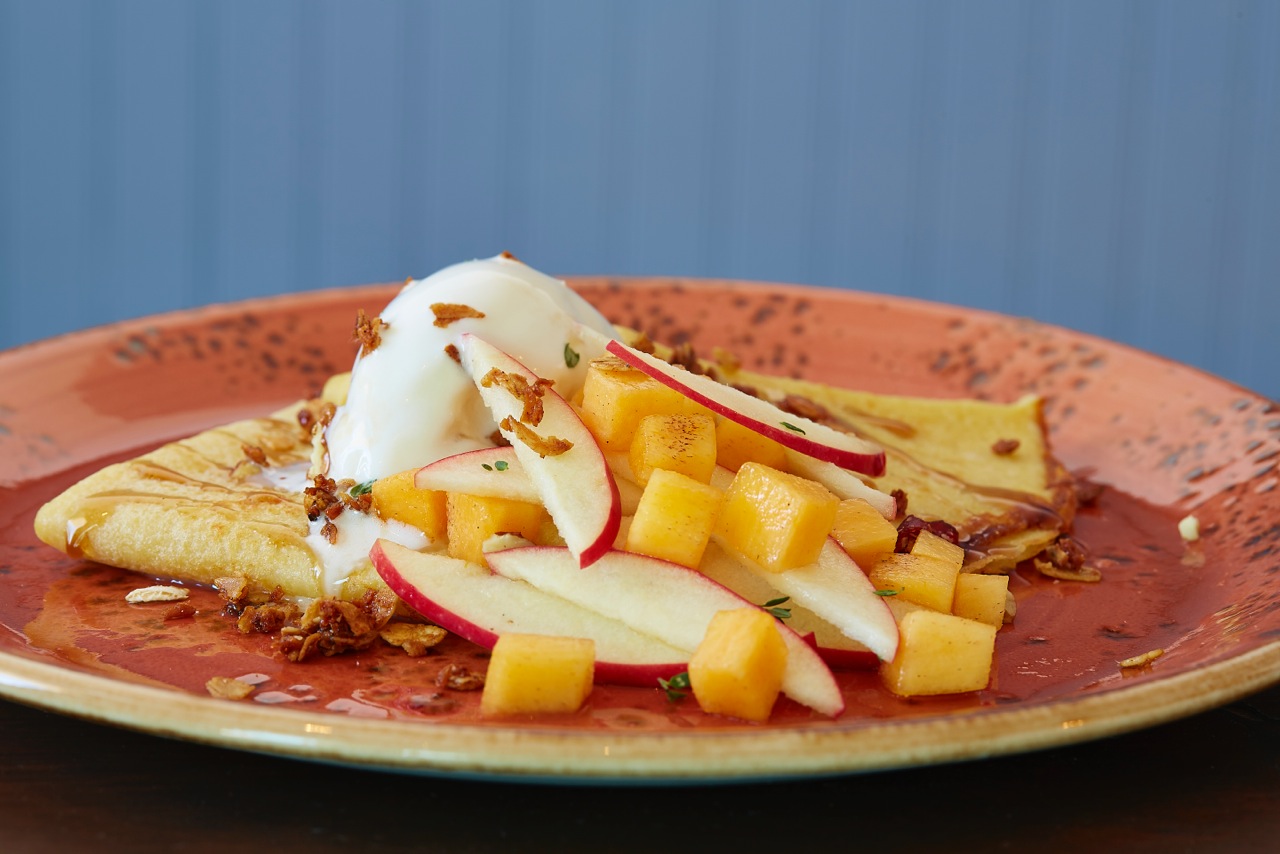 order the
veal cheeks, so I did, as enchanted as my advisers
by the meat’s lush texture, braised to velvety
tenderness and served with hearty Tokyo turnip, baby
carrots, baby onions, bacon and black pepper
spaetzle. ($24.25).
order the
veal cheeks, so I did, as enchanted as my advisers
by the meat’s lush texture, braised to velvety
tenderness and served with hearty Tokyo turnip, baby
carrots, baby onions, bacon and black pepper
spaetzle. ($24.25).
Desserts play the same role of
impressing by being homey and honest, including a
Basque-style cake with lemon ice cream and a frozen
citrus soufflé ($9). Cream
cheese crêpes with huckleberry compote on a
Graham cracker (left) were as light as air and
rich as a dollop of lemon ice cream can make
them ($8.50).
Gemma’s cocktail list is long,
its wine list modest but well chosen.
You’re undoubtedly going to see
both Chef Stephen and Allison in the dining room,
because they truly do want to know what you think of
everything they have so carefully crafted to reveal
what I must only suppose is a reflection of their
own very personal sense of hospitality.
Gemma is open Wed.-Sun. for dinner.
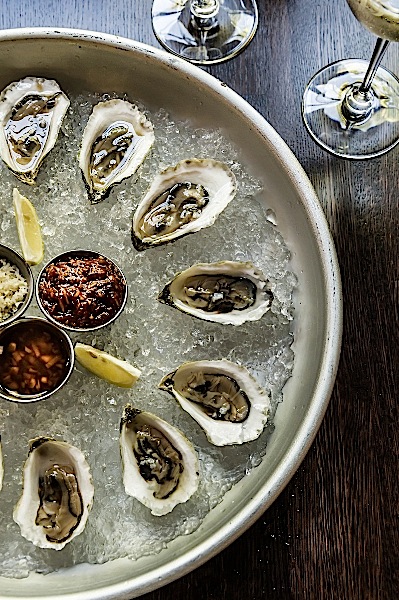 BOULEVARDIER
BOULEVARDIER
1530
Main Street
408
N. Bishop Avenue
214-942-1828
dallasboulevardier.com
Though new to me, Boulevardier has
been around for two years and continues to draw a
very, very regular crowd that packs this convivial
French bistro run by Brooks and Bradley Anderson, chef Randall
Copeland and chef Nathan Tate. You may
indeed have the sense of a Parisian eatery when you
see the deliberately aged walls, scuffed wooden
floors, oysters on ice, painted wooden chairs, and
wall rack of wines.
Alas, Boulevardier is much louder
than any Parisian bistro I’ve ever been to, as much
a result of such hard surface materials as it is the
decibel levels Dallasites can reach while conversing
with friends.
The food, however, is solid, and
you can tell the staff has been assiduous in getting
classics like onion soup just right ($10); their
version is about as fine and flavorful and sweet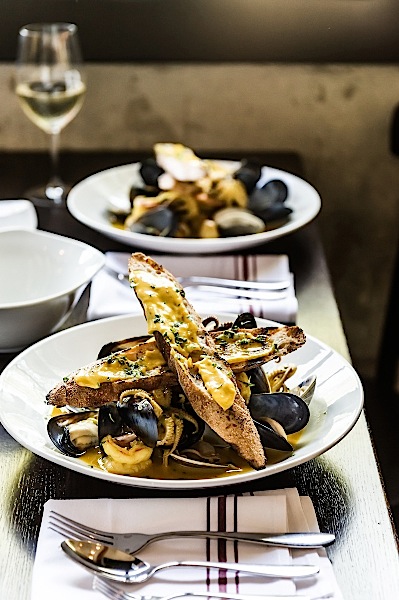 and caramelized as any I’ve had on
the Left Bank. There is a hefty marrow bone roasted
to succulence here, and while the crawfish beignets
might skirt authentic French tradition, call them
Creole and be happy you ordered them, with a rich
aïoli for dipping ($12).
and caramelized as any I’ve had on
the Left Bank. There is a hefty marrow bone roasted
to succulence here, and while the crawfish beignets
might skirt authentic French tradition, call them
Creole and be happy you ordered them, with a rich
aïoli for dipping ($12).
Of course there’s bouillabaisse—a
little expensive at $30 but generous—and braised
lamb neck with toasted orzo and a red wine braisage
($27), which came to the table far less bubbly and
hot than I expected: apparently they transfer the
cooked ingredients to an iron casserole but do not
heat things through enough.
For dessert, go with Nancy’s
bread pudding ($8) lavished with huckleberry jam,
bourbon butter sauce and vanilla ice cream. Then
maybe sit back, finish your glass of Grenache or
nurse a Cognac, and perhaps recall just such a place
from your salad days and your first dinner in Paris.
Open
Tues.-Sun. for dinner; Sat. & Sun. for brunch.
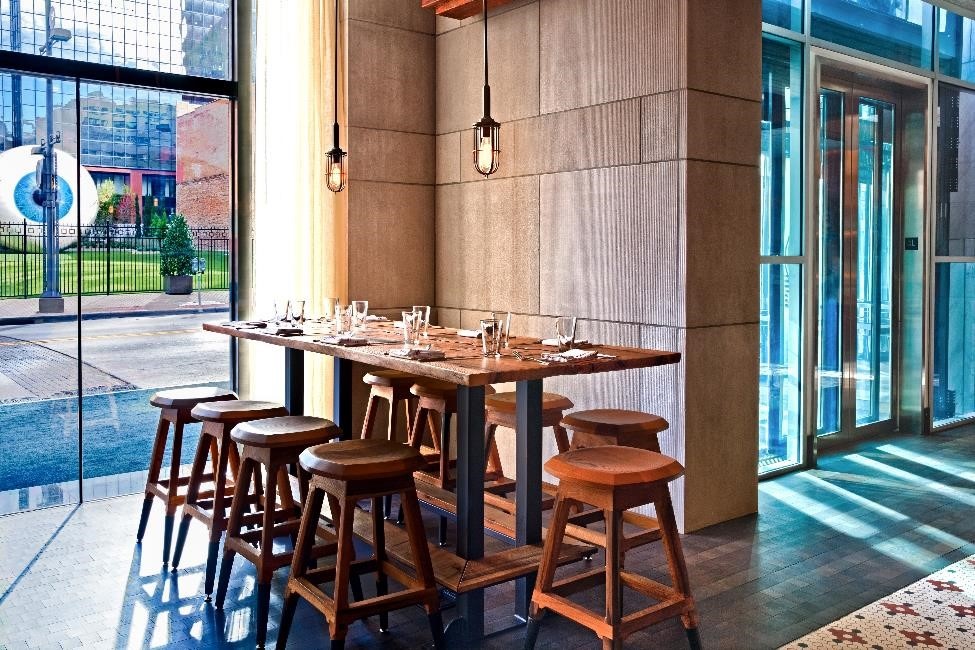 CBD
PROVISIONS
CBD
PROVISIONS
214-261-4500
http://www.cbdprovisions.com
Set next to the Joule Hotel
downtown, CBD Provisions (no one ever told me what
those letters stood for) has successfully avoided
the onus of being a hotel dining room though it
serves breakfast, lunch and dinner from the long,
open kitchen here, supervised by Chef Michael
Sindoni, who is so admirably veering away from the
expected by offering an array of dishes that ask his
audience to be a bit adventurous.
The walls are brick, the floors
planked from salvaged wood, the lighting low (the
waitress may bring you a flashlight), and the noise
level is high, not helped by throbbing piped-in
music. It’s
a décor that will remind you of many others
you may have seen in so-called American brasseries,
but the comparisons stop when you get the
menu. What
will not is the huge big blue eye sculpture across
the street that stares eerily in at you through
the window (above)
You could, of course, play it
safe and order pork rinds or a burger here, but the
great stuff goes in other directions. Start with the
“Little goat pie,” which is terrific, not least its
perfect pastry ($6), and if you love tripe—which
rarely appears on Dallas menus—dive in at CBD: it’s
done with spicy house-made chorizo and smoked
paprika, enriching the taste and tender texture of
the tripe magnificently ($12).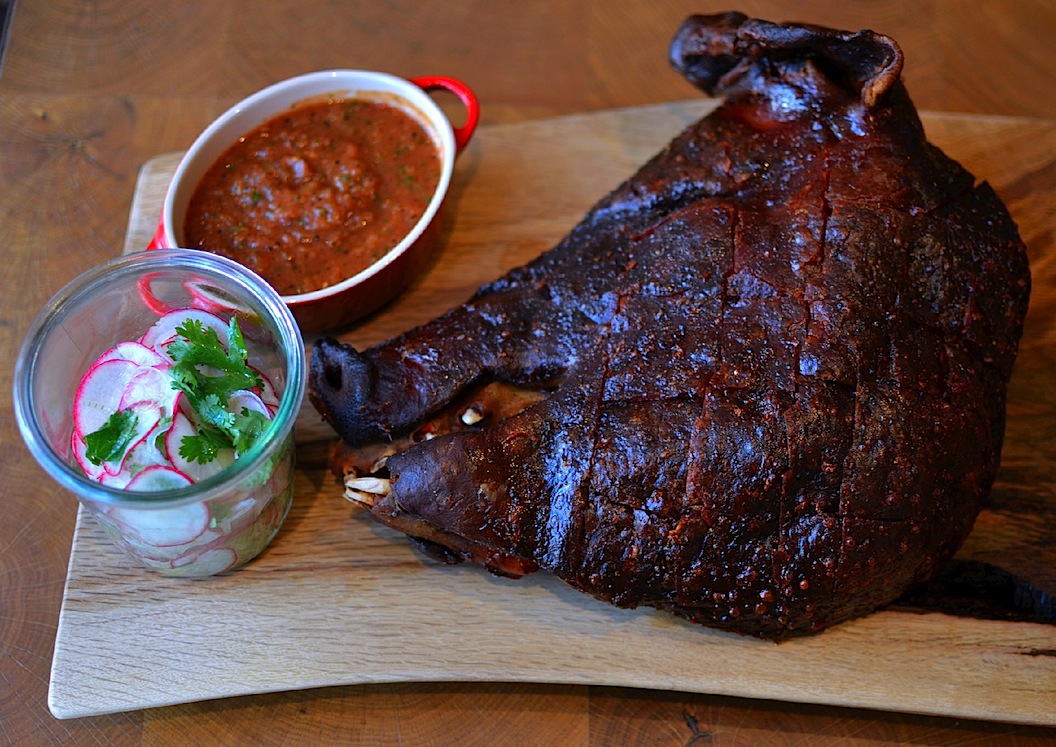
Among the large plates there is
superb heads-on shrimp with grits ($19), more spicy
condiments—this time Italian n’duja
chile, and local peppers. Sindoni packs everything
he cooks with big, tantalizing flavors. Only a
pork shoulder ($18), cooked for 18 hours, didn’t
quite have the savory impact of the other dishes I
tried.
And then there’s the Berkshire
pig head carnitas meant for a table to share ($43).
Yes, it really is a pig’s head and it ain’t pretty
and it overlaps the plate. From the skin to the
custard-like flesh beneath the pig’s cheeks, it is a
unique marvel, enhanced with roasted tomatillo salsa
and hot tortillas with which to soak up the juices. Does
anyone actually order this thing? Well, aside from
the one slapped down on my table, a remarkable
number of pig’s heads were headed to others’
throughout the night.
You may skip dessert but
shouldn’t: the cinnamon bread pudding with salted
sorghum caramel, brown butter ice cream and spiced
pecans, and the seasonal fruit cobbler with almond
oat crumble and horchata
ice cream are as delicious as any desserts in Dallas
right now.
The wine list is strong in its
by-the-glass section, but the small bottle selection
lacks focus and has only five wines under $50 on it.
CBD Provisions takes chances but what I
like especially about Sindoni’s ideas is that they
fall well within modern Texas cookery while nudging
guests to take a chance and be amazed.
Open for breakfast, lunch and dinner daily.
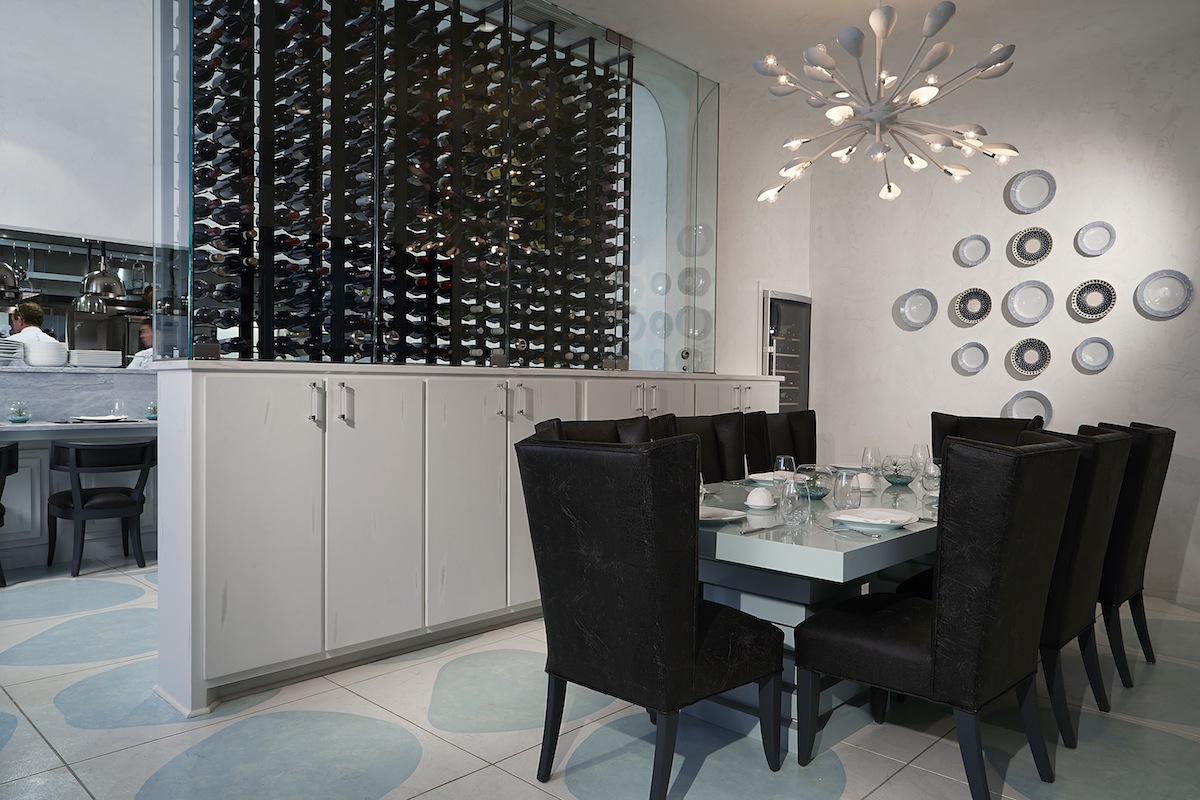 SPOON BAR &
KITCHEN
SPOON BAR &
KITCHEN
8220
Westchester Drive
214-368-8220
spoonbarandkitchen.com
At a time when the comfort and
cosseting of guests seems rare and respect for the
rigors of the hard-won mastery of cuisine fading,
Chef John Tesar’s Spoon Bar & Kitchen is a
reminder that true excellence is not about
spontaneous combustion in the kitchen.
Tesar, who chose to stay in Texas
after earning his impressive credentials in New York
and Las Vegas, first built his rep at The Mansion on
Turtle Creek in Dallas, then, following a zig-zag of
career moves, returned to open Spoon—certainly the
most exciting seafood restaurant to open since New
York’s Marea five years ago and Le Bernardin back in
the 1990s.
The food is deceptively but
exquisitely simple, from the service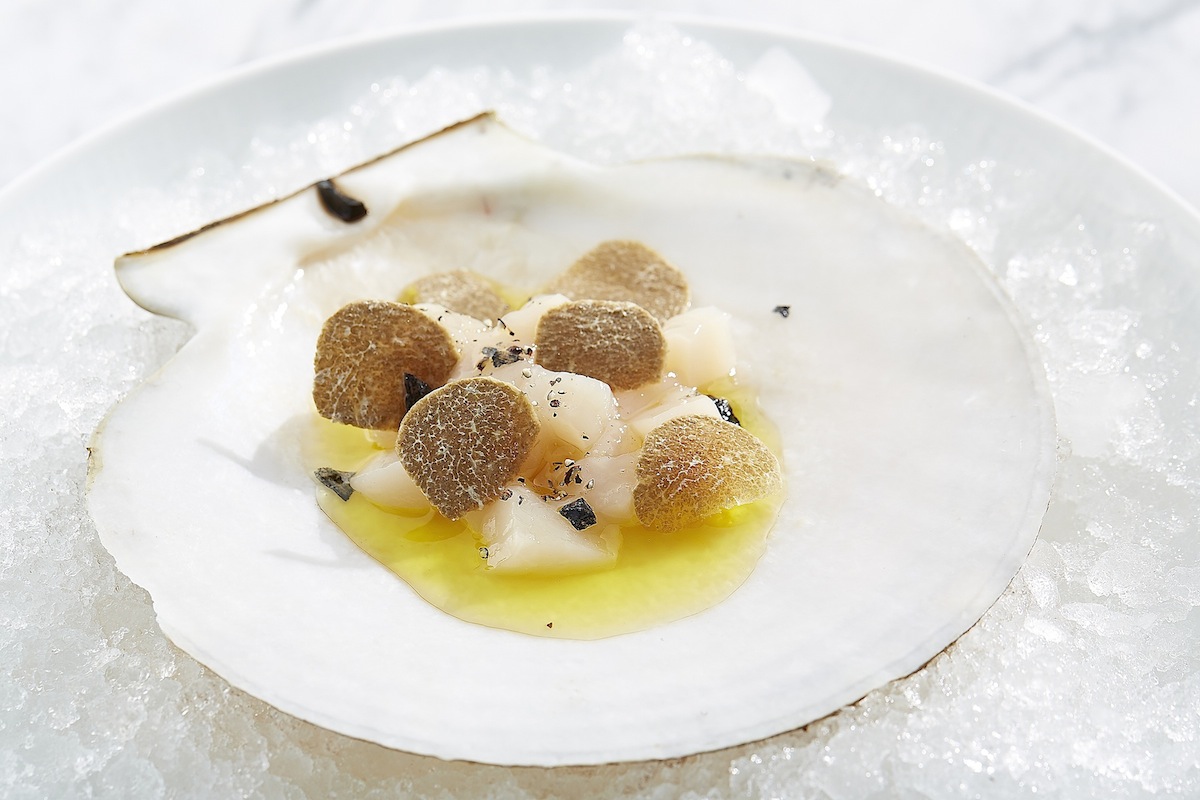 of raw
seafood like yellow tail with Texas ruby red
grapefruit and toasted beets to Singapore style
chili lobster and Texas toast. His
classic French training shows in the intensity of
his reduction of a red wine sauce with a swordfish
steak in a wild mushroom crust, and the recipe for
his potato gnocchi with jumbo lump crabmeat and
black truffle essence should be required reading at
every culinary school.
of raw
seafood like yellow tail with Texas ruby red
grapefruit and toasted beets to Singapore style
chili lobster and Texas toast. His
classic French training shows in the intensity of
his reduction of a red wine sauce with a swordfish
steak in a wild mushroom crust, and the recipe for
his potato gnocchi with jumbo lump crabmeat and
black truffle essence should be required reading at
every culinary school.
Add to this a low-lighted,
low-decibel level dining room in soft grays and sea
foam colors, a pleasingly dressed staff that knows
its stuff and is cordial without a whiff of
pretension, and you have a restaurant whose
coalescence of great, innovative food and a
sophisticated, casual ambiance conspire to make
Spoon a totem of fine dining in Texas right
now.
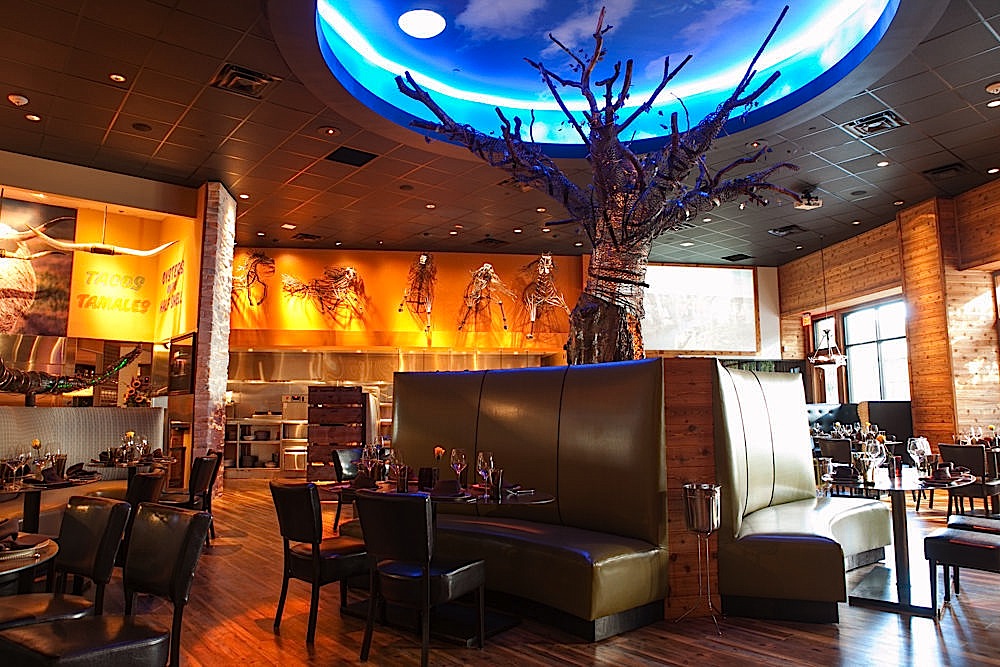 Stampede
66
Stampede
66
1717 McKinney Avenue
214-550-6966
www.stampede66.com
Stephan Pyles is no stranger to me:
thirty
years ago his Routh Street Café was one of
the pioneers of New Texas Cuisine, and I’ve praised
several other of his restaurants in the years since,
calling him Chef of the Year for his namesake
restaurant Stephan Pyles. Now, with Stampede 66 (the
numbers refer both to Philips 66 gas stations and to
the iconic Route 66), he has culled all he’s learned
and all he truly loves about the old and new
traditions of his home state and brought them to
vivid life in a hugely entertaining restaurant with
video 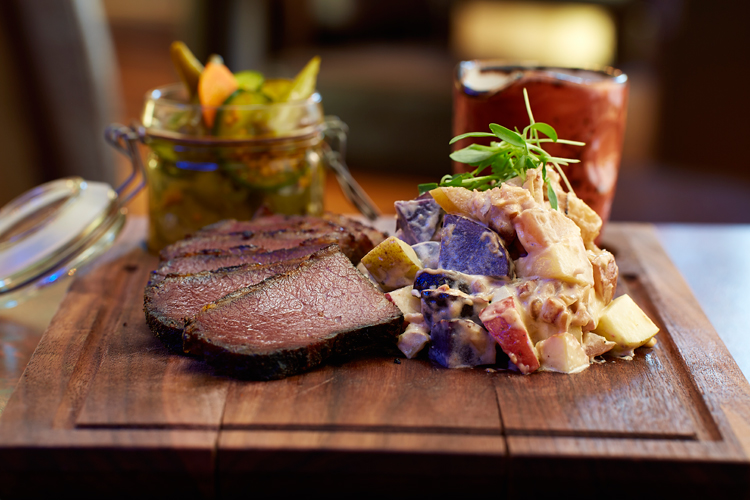 screens projecting rodeo
scenes and Texas sayings, like, Molly Ivins’s “Next
time I tell you someone from Texas should not be
President of the United States, please pay
attention,” along with fine sculptures by leading
western artists, cowhide upholstery and a wondrous collection
of longhorns.
screens projecting rodeo
scenes and Texas sayings, like, Molly Ivins’s “Next
time I tell you someone from Texas should not be
President of the United States, please pay
attention,” along with fine sculptures by leading
western artists, cowhide upholstery and a wondrous collection
of longhorns.
Then there’s the food—the
sublimation of down-home cooking into great cuisine,
from the crunchy honey-fried chicken with buttermilk
biscuits and mashed potato tots to the lush shrimp
and grits and smoky barbecued beef brisket with
potato salad (right).
For dessert you can’t go with anything—butterscotch
pudding with salted caramel or sweet corn icebox pie
or the chocolate custard and ice cream float with a
bottle of the coveted real sugar Dr Pepper.
Anyone who cannot wrap his arms
around this food is very probably without a pulse.
Stampede 66
is open for Lunch Mon.-Fri., for dinner nightly.
MR.
MESERO
4444 McKinney Avenue
214-780-1991
mrmesero.com
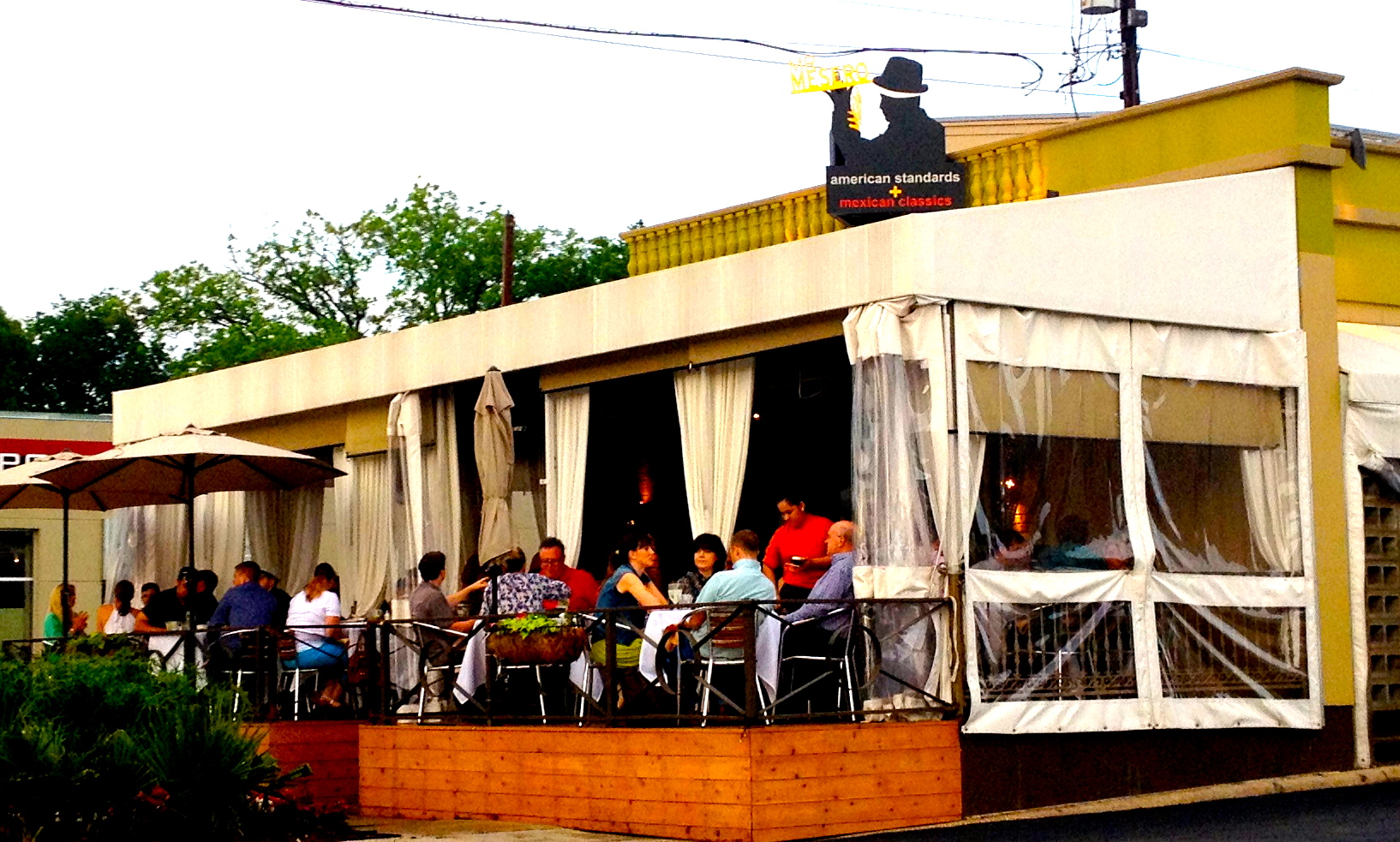 “Mesero”
in Spanish means waiter, and owner Mico
Rodriguez, is evident in the dining room doing
whatever needs to be done to make his guests happy. The place
doesn’t look like much—white cinderblock walls,
concrete floor, bare tables, some big bright
artwork, and that’s about it. They don’t take
reservations but you won’t wait long for a table to
free up; things move fast here. It’s a popular
family spot.
“Mesero”
in Spanish means waiter, and owner Mico
Rodriguez, is evident in the dining room doing
whatever needs to be done to make his guests happy. The place
doesn’t look like much—white cinderblock walls,
concrete floor, bare tables, some big bright
artwork, and that’s about it. They don’t take
reservations but you won’t wait long for a table to
free up; things move fast here. It’s a popular
family spot.
I can’t say Mr. Mesero is forging
any new frontiers for Mexican food in Dallas, but
the foremost criteria for the genre is that it taste
very fresh, not pre-cooked, based on quality
ingredients (not often the case), and have a good
base salsa. Here
those criteria are met across the board, not least
in the red chile salsa that is as bright as a penny
and complex in seasonings not overpowered by mere
heat.
Best thing to do is to order the
#5, a combo of cheese enchilada, brisket taco,
refried beans and rice ($10.95), and you’ll get a
good idea of the cooking here. As at so
many Mexican restaurants, categories are mainly
swappings of proteins wrapped inside tacos,
enchiladas, bocaditos,
and so on, so there’s a lot of repetition. Trust me,
the #5 will tell you all you need to know. And it
won't cost you much.
Toss in a Negro Modelo ($5), tax and tip and
you’re full and out the door for under twenty bucks.
Open
daily
for lunch through late night.
HOTELS
 The
two-year old Omni,
owned by the City of Dallas and conveniently
connected to the Dallas Convention Center, is a vast
complex of 1,001 guestrooms, with 67 luxury suites,
where you could wander seemingly forever, which is
nearly as much time as it themselves are impeccably
modern if soul-less and the bathroom, surprisingly
small for a brand new hotel. Otherwise,
amenities are good, except that the hotel charges
for in-room WiFi—not exactly a competitive edge when
most hotels have abandoned fees. The Texas Spice
restaurant downstairs has an extensive morning
buffet. There is also Bob’s Steak & Chop House, which
I did not try, but it has a very extensive wine
program.
The
two-year old Omni,
owned by the City of Dallas and conveniently
connected to the Dallas Convention Center, is a vast
complex of 1,001 guestrooms, with 67 luxury suites,
where you could wander seemingly forever, which is
nearly as much time as it themselves are impeccably
modern if soul-less and the bathroom, surprisingly
small for a brand new hotel. Otherwise,
amenities are good, except that the hotel charges
for in-room WiFi—not exactly a competitive edge when
most hotels have abandoned fees. The Texas Spice
restaurant downstairs has an extensive morning
buffet. There is also Bob’s Steak & Chop House, which
I did not try, but it has a very extensive wine
program.
I also stayed out at
the Four
Seasons Resort and Club Dallas (below) at Las
Collinas,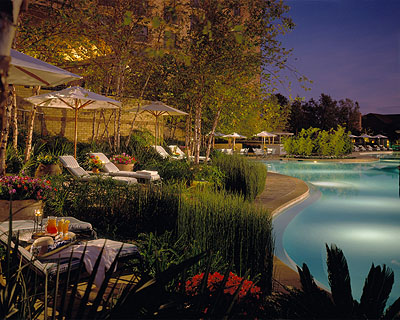 which is a
fine place to chill out if you have no expectations
of heading into town, because there is no transport
except taxi or town car, and they are very
expensive. But if golf and the 25,000 square foot
pool, even some sand, are your wont, this is a big
sprawling place—far larger than most Four Seasons
properties—spread over 400 acres, with 431
guestrooms and villas adjacent to the golf course. The main
restaurant, Café
on the Green, is where I had an enjoyable
American lunch of generous lobster salad, a French
dip sandwich soaked in pan juices, and updated, not
too sweet coconut cream pie, and I was happy
to see that the wine list here, unlike almost
everywhere else in Dallas, has a fine selection
of about a dozen Texas labels, including the
impressive Duchman Family Winery wines.
which is a
fine place to chill out if you have no expectations
of heading into town, because there is no transport
except taxi or town car, and they are very
expensive. But if golf and the 25,000 square foot
pool, even some sand, are your wont, this is a big
sprawling place—far larger than most Four Seasons
properties—spread over 400 acres, with 431
guestrooms and villas adjacent to the golf course. The main
restaurant, Café
on the Green, is where I had an enjoyable
American lunch of generous lobster salad, a French
dip sandwich soaked in pan juices, and updated, not
too sweet coconut cream pie, and I was happy
to see that the wine list here, unlike almost
everywhere else in Dallas, has a fine selection
of about a dozen Texas labels, including the
impressive Duchman Family Winery wines.
❖❖❖
NEW YORK CORNER
By John Mariani
Rôtisserie Georgette
14 East 60th Street (near Madison Avenue)
212-390-8060
www.rotisserieg.com

In
the often backbiting NYC restaurant world, I doubt
there is anyone who enjoys a higher likeability
rating than Georgette Farkas (below), who,
having spent 17 years as communications director
for chef-restaurateur Daniel Boulud, finally did
what she had originally intended to do two decades
ago--open her own restaurant.
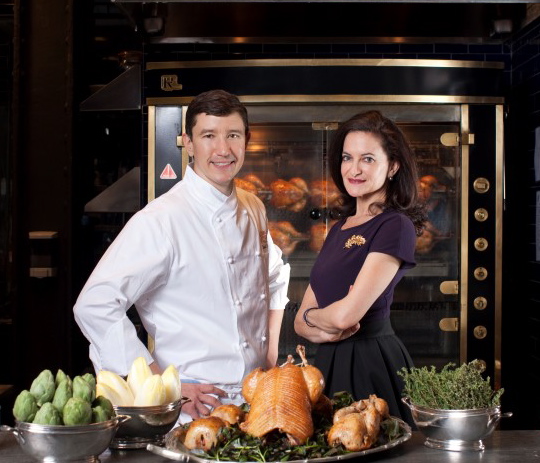 New York
born, Ms. Farkas began cooking professionally at 16,
attending École Hôtelière de
Lausanne, then training at Michelin-starred
restaurants like the Hôtel Richmond in Geneva,
Hôtel de Crillon in Paris, Moulins de Mougins,
and Louis XV in Monaco before joining the marketing
side of Boulud’s expanding empire. Her
experience as a bartender at Blake's Hotel in London
and with night club impresario Régine in
Paris only added more European polish to her New
York savvy.
New York
born, Ms. Farkas began cooking professionally at 16,
attending École Hôtelière de
Lausanne, then training at Michelin-starred
restaurants like the Hôtel Richmond in Geneva,
Hôtel de Crillon in Paris, Moulins de Mougins,
and Louis XV in Monaco before joining the marketing
side of Boulud’s expanding empire. Her
experience as a bartender at Blake's Hotel in London
and with night club impresario Régine in
Paris only added more European polish to her New
York savvy.
And now
she is off on her own, with a namesake restaurant
built around a piece of twirling kitchen equipment
that turns out scores of roast chickens each night,
along with other meats and seafood. The long dining
room, in low light, has steel girders and tall brick
walls hung with antique mirrors, swag curtains and
an Aubusson
tapestry. Banquettes are done in chocolate brown
leather; tables are bare; the noise is tolerable.
The open kitchen’s front is decorated with
blue tiles.
The courteously dressed East
Siders took to the restaurant immediately, dining
early, so that reservations are easier to come by
after 8 o'clock than before.
When
Rôtisserie Georgette opened this year,
expectations were high, given Ms. Farkas’
reputation, but the early word-of-mouth on the
consistency of the food was less than exultant.
On my first visit, about a month after the
restaurant opened, I enjoyed myself but found some
of the cooking lackluster. Even the vaunted chicken
was tepid, rather than hot; nor was it the best
version of the bird in a town with plenty of
exemplars.
For reasons not explained, Ms. Farkas fired her
first chef, bringing on Chad Brauze (above, with Farkas),
formerly a sous-chef at Restaurant Daniel.
Now, not only has the Amish-bred chicken
improved but his additions to the menu have made
Rôtisserie Georgette what it was intended to
be. Indeed, despite being meat-centric, the
menu will have enormous appeal to any vegetarian who
has no problem with the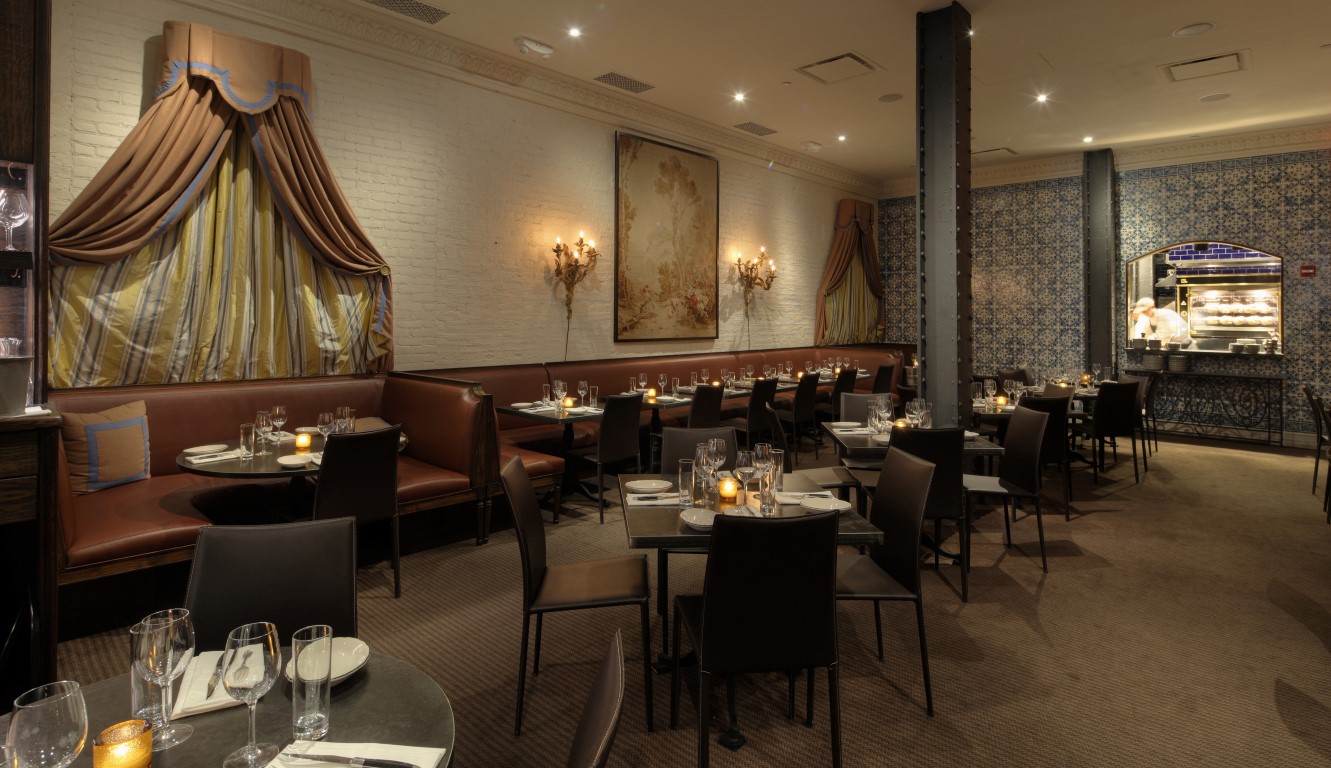 lavish use of butter and
cream.
lavish use of butter and
cream.
Thus, on
my second visit, with Brauze aboard, I was giddy
with almost every appetizer, from roasted artichokes
and peppers with a lemon-garlic aïoli ($16) to
roasted leeks with duck prosciutto, mâche
lettuce, pignoli and grilled onion vinaigrette
($14). There were three pâtés on one
plate ($21), each smoothly textured and distinctive,
with fine toasted bread, and a generous portion of
foie gras with a rhubarb chutney and candied
pistachios ($28). Only the gnocchi
à la parisienne ($18 as appetizer or
$26 as a main) disappointed; on two tries it was too
soft and gummy. But then, that ill-conceived
dish almost always is.
Before
turning to those chickens, I must comment on the
side dishes of vegetables, like the whole roasted
glazed carrots ($9) that you might want to pick up
with your fingers if they weren’t so hot (below); the
well buttered spring peas with fresh mint ($11) that
are just perfect at this time of year; crispy
pencil-thin asparagus enhanced with lemon, coriander
and a rich Hollandaise ($11); brown butter-enriched
spinach scented with garam masala cream ($10); and
wild mushroom fricassée persillade ($12).
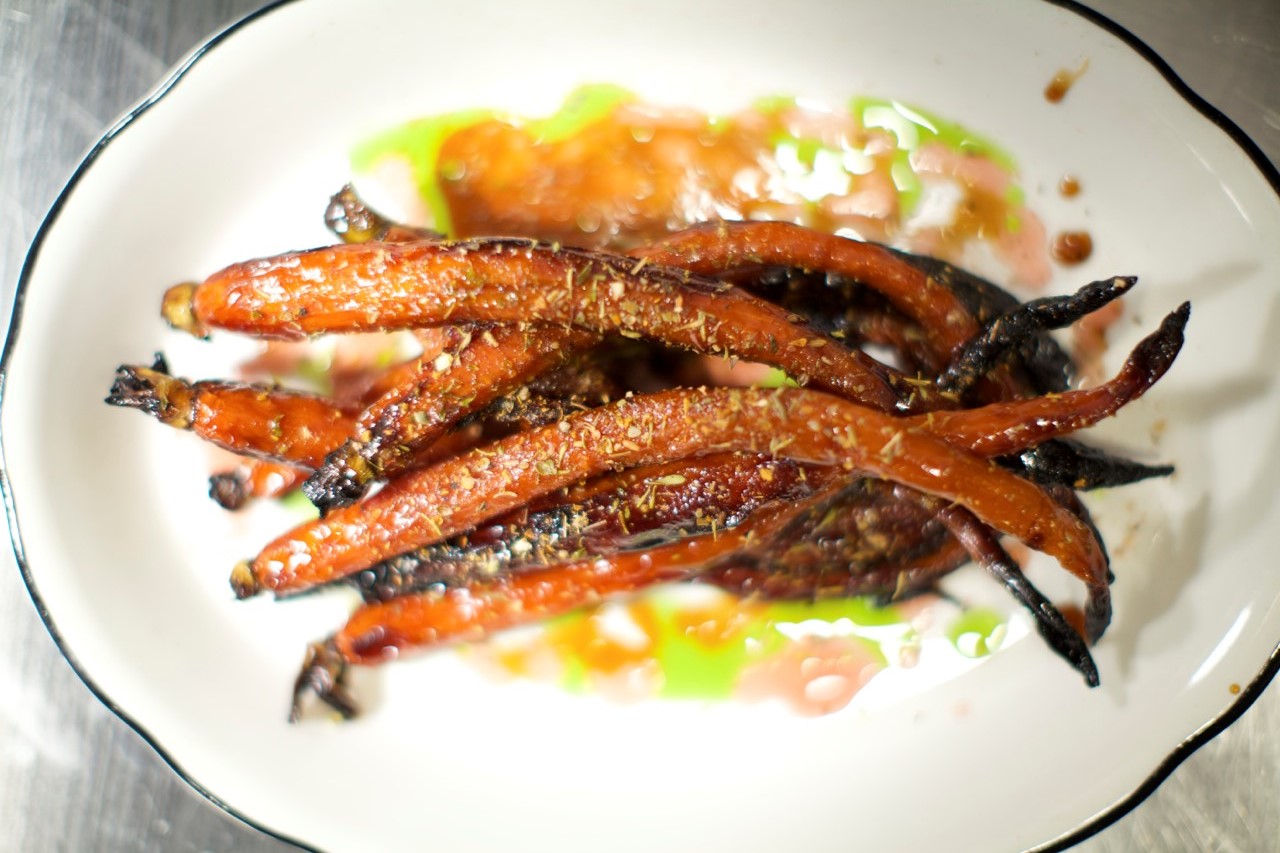 So. The
chicken. It is now everything it should be, brined
in advance, rotated to garner an even, crisp skin,
very juicy within, and it comes with a variety of
sauces--herbes
de Provence; garlic, tomato and tarragon; or
Grand Mère, with red wine, mushrooms and
bacon--and at a very reasonable price of $24. There
is a more flamboyant version, for two at $36 per
person, called poule de Luxe,
which comes as a whole chicken whose breast is
stuffed with panko crumbs and wild mushrooms and
topped with seared foie gras as gilding. And,
believe me, two people will take plenty home; I got
two lunches out of the leftovers.
So. The
chicken. It is now everything it should be, brined
in advance, rotated to garner an even, crisp skin,
very juicy within, and it comes with a variety of
sauces--herbes
de Provence; garlic, tomato and tarragon; or
Grand Mère, with red wine, mushrooms and
bacon--and at a very reasonable price of $24. There
is a more flamboyant version, for two at $36 per
person, called poule de Luxe,
which comes as a whole chicken whose breast is
stuffed with panko crumbs and wild mushrooms and
topped with seared foie gras as gilding. And,
believe me, two people will take plenty home; I got
two lunches out of the leftovers.
Fat is
neither wasted not held back at Rotisserie
Georgette, and that goes for the roasted potatoes,
the baked potato with Parmesan, and the butter-rich
mashed potatoes. They taste fabulous.
There are
several non-chicken items on the menu, but I only
tried them under the former chef’s tenure, so I
can’t really report on the two: roast quail in
red wine sauce ($42) or the suckling pig ($450).
Sadly, the latter is only served for 6 to 8 guests,
when you can get an individual portion at other
places around town. There is also harissa-marinated
loin of lamb ($32), and, again for two, côte
de boeuf, whose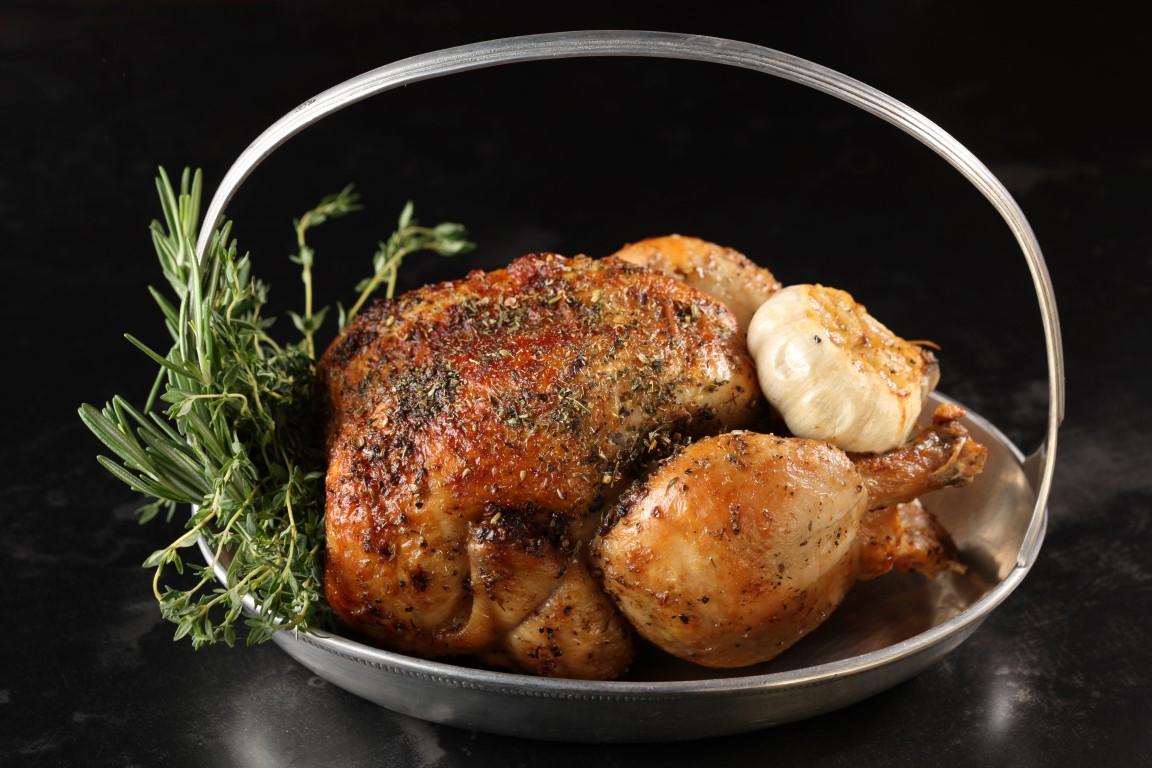 price of
$60 per person for a 20-ounce cut works out to
considerably less than some other restaurants in
town are charging for the same, like $145 at Minetta
Tavern.
price of
$60 per person for a 20-ounce cut works out to
considerably less than some other restaurants in
town are charging for the same, like $145 at Minetta
Tavern.
Ms.
Farkas attracted patîssier Nicole Kaplan away
from Eleven Madison Park, but she is toeing a more
traditional French bistro line here, with excellent
versions of tarte Tatin, chocolate soufflé,
and pot de crème.
The wine
list is just about as large as it should be for this
venture, but it’s top heavy in price for a
rôtisserie restaurant. It might be nice even
to have some good Beaujolais by the carafe, as you’d
find in France.
But
Georgette has been a big success, not least because
people were waiting for Ms. Farkas to open just such
a place as a reflection of her own ebullient, ever
cordial personality. That goes a long way, and,
though it is not a novel concept, I suspect we’ll
see similar restaurants being opened around the U.S.
very soon. (Plenty of out-of-town chefs have been
dining here.) But then, they won’t have
Georgette Farkas running them.
Open for lunch and dinner Mon.-Sat.
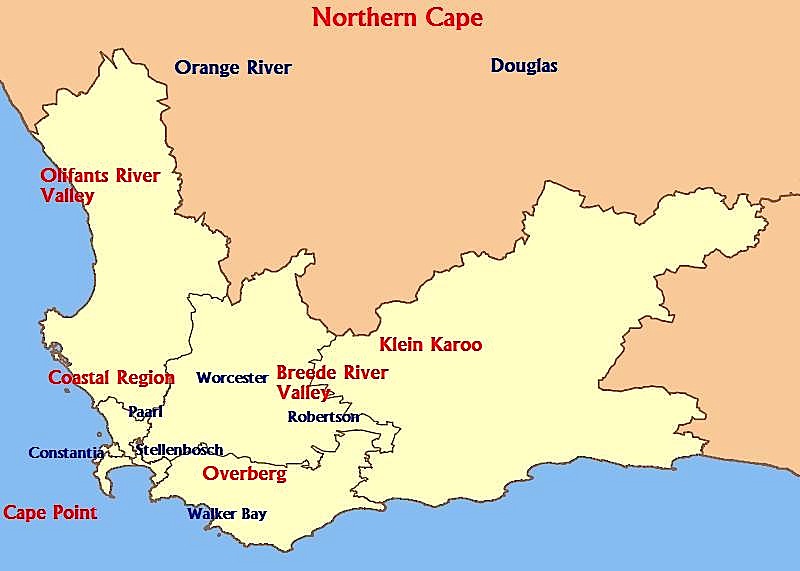
SOUTH AFRICAN WINERIES GO HEAD TO HEAD WITH OTHER NEW WORLD PRODUCERS
By John Mariani
At
a wine luncheon in New York last week, I was happy to
find that South African wines have come so far in the
past ten years.
I didn’t say “so fast,” because South
Africa has been making wines far longer than most “New
World” producers like California, Australia, New Zealand
and much of South America. Viticulture has been part of
the country’s economy since the first plantings in the
1650s.
Back then, most
vineyards were planted with Muscat to make the sweet
dessert wines of Costantia, which are still being
produced. Today, however, the majority of wines are
white, with about 35 percent from the Chenin Blanc
grape, there called Steen. Currently there are
about 270,000 acres planted, about the same territory as
in Bordeaux.
Yet, for all that history, it was
only in 1973 that Wine of Origin labeling took legal
hold; and well into the 1990s the country’s Co-Operative
Winegrowers’ Association was still dictating production
quotas, minimum prices and predetermined production
areas, which served to hamper small estates in favor of
bulk wineries.
Add to this
an international resistance to South African exports
because of the government’s apartheid policies up
through 1994, and 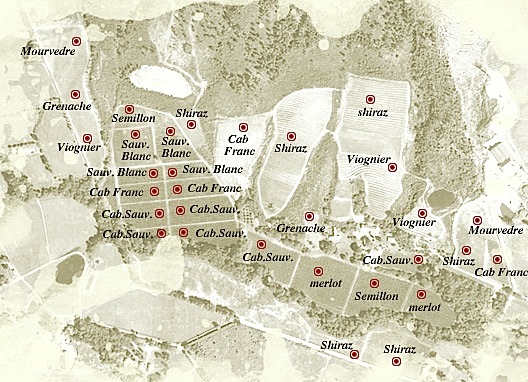 the chances of the country’s better
producers to compete on the world market were slim.
Indeed, few wine stores in the U.S. carried more
than a handful of South African wines, like those from
Hamilton Russell Vineyards, Kanonkop Wine Estate, La
Motte, and Warwick Estate. Those days are over and
the best small estates, like those whose wines I sampled
last week, are now coming into the global market and
have U.S. importers.
the chances of the country’s better
producers to compete on the world market were slim.
Indeed, few wine stores in the U.S. carried more
than a handful of South African wines, like those from
Hamilton Russell Vineyards, Kanonkop Wine Estate, La
Motte, and Warwick Estate. Those days are over and
the best small estates, like those whose wines I sampled
last week, are now coming into the global market and
have U.S. importers.
I was by far
most delighted at the tasting with the Chenin Blancs:
very crisp, very cleanly made wines from a varietal so
often too grassy and tasting oily like petroleum. But
these were balanced in fruit and acid, and, unlike the
better Chenin Blancs from France’s Loire Valley, are
very decently priced, like the 2012 Mulderbosch ($12),
the 2012 Botanica Skurfberg ($24), and the 2012 Radford
Dale, though this last is pricey at $40.
The
Chardonnays tasted were equally well balanced, with just
enough wood to round them out and a sensible alcohol
level that never went beyond 13.5 percent. I
particularly liked the 2011 Neil Ellis Elgin ($28),
which is grown in a cool climate about 45 miles east of
Cape Town, and the 2012 Hamilton Russell ($33), whose
estate is located in the appropriately named region of
Hemel en Aarde (Heaven and Earth) Valley.
There has
been, among the small producers, an effort to mimic--or
bear homage to--Bordeaux-style blends of Cabernet
Sauvignon, Merlot, and other varietals, well displayed
in a 2012 Boekenhoutskloof “Chocolate Block” ($33)--its
vineyards are shown above--a complex blend of Syrah,
Grenache, Cabernet Sauvignon, Cinsault and Viognier,
while the 2011 Rust en Vrede ($36), with Cabernet, Syrah
and Merlot still needs some aging to come into focus.
The Rust en Vrede estate is shown below.
 The Syrah wines were
particularly interesting in that they indicated two
stylistic renderings of that varietal. An elegant example of one
style was the 2011 Mullineux Family Wines ($30),
definitely a nod toward Rhône Valley tradition,
with the big forward fruit of the grape toned down by
careful picking and barrel aging.
The Syrah wines were
particularly interesting in that they indicated two
stylistic renderings of that varietal. An elegant example of one
style was the 2011 Mullineux Family Wines ($30),
definitely a nod toward Rhône Valley tradition,
with the big forward fruit of the grape toned down by
careful picking and barrel aging.
On the other flank are
Syrah-based wines that taste far more like overripe
examples from California, Australia and New
Zealand--where the name Shiraz prevails--that are very
bold, often grapey, fruit forward, but, ultimately, one
dimensional. One that fell in between styles was the
2011 Spice Route Chakalaka “Rhône Blend” ($23), a
blend of Mourvèdre, Cinsault and Grenache, along
with the Syrah.
These and
others of the nearly 30 wines presented were impressive
pretty much across the board, showing that South
Africa’s wine industry, at least among the small
producers with young owners, can hold its own in
quality, and most certainly in price, with the best of
the New World wines.
❖❖❖
Wine Column Sponsored by Banfi Vintners
 A Season with a
Reason for Wine
A Season with a
Reason for Wine
by Cristina Mariani-May
co-CEO of Banfi Vintners
America's leading wine importer
May is a
great month for wine, at least around my house. Then
again, around my house, every month is a great month for wine!
month is a great month for wine!
But at this time of year
it just seems like we’ve got so many more reasons to
open something fun and different.
We celebrate Mother’s Day in honor
of my mother’s bubbly personality with a sparkling
rosé. Fermented
in the bottle and made from 100% Pinot Noir, Cuvee Aurora
Rosé evokes a bouquet of flowers in a
glass. Like
Mom herself, Cuvee Aurora starts off charming and
demure, but the more you get to know her, the more you
realize how complex and deep she is! And you
always end up wanting more, so make sure you have an
extra bottle or two on hand because that ‘aperitivo’
will likely stay with us for lunch too!
This month
we also celebrate my oldest son’s birthday, with a
wine that I believe will quite accurately describe
him someday soon – Cum Laude,
Latin for “with Honors” which is surely the way this
bright and thoughtful young man will receive his
diploma! The wine is a “super Tuscan” blend of
Sangiovese for backbone, Cabernet for muscle, Merlot
for a soft note, and Syrah for that “sparkle in the
eye.” 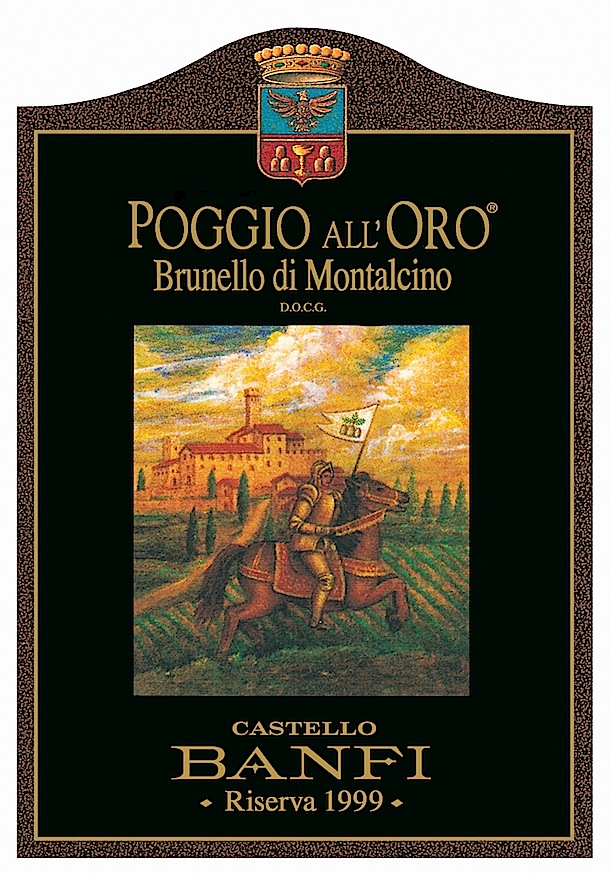 All these wonderful
attributes combined in one wine and one brilliant
young man!
All these wonderful
attributes combined in one wine and one brilliant
young man!
On the same day we celebrate my
father’s birthday. Saving
the best for last, we toast him with something
appropriately noble and well-aged, such as a back
vintage of our Poggio
all’Oro, a single vineyard ‘Riserva” of Brunello
di Montalcino. Coming
from one of the oldest vineyards on our estate and
bearing the most ideal “micro-climate” for this
persnickety varietal, Poggio all’Oro is only made in
those unique years when all the conditions are right –
in fact, we’ve only produced it in 11 of the past 25
vintages! So
just like Dad, it is a rare bird, with a lot to say,
giving you a lot to think about, and lingering on the
memory.
Cristina Mariani is not related by family or through business with John Mariani, publisher of this newsletter.
DEPT OF WRETCHED EXCESS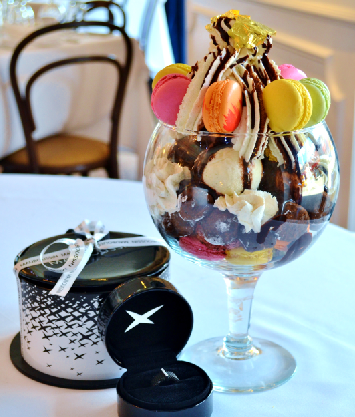
NYC
restaurant Bagatelle
has put a
$1,000 ice cream sundae on its menu called the
"Mauboussin Mega Sundae," consisting of vanilla ice
cream, Dom
Pérignon Rosé sorbet topped with chocolate
truffles, macarons, whipped cream, chocolate vodka
sauce, and "gilded brownies" with gold leaf. In
addition, it comes with Mauboussin ring made of black
steel and white gold on the side.
DUH!
"Modern Texas cuisine is what happens when
creative chefs with contemporary Texas sensibilities
create dishes using Texas ingredients and traditional
Texan cooking techniques."—Leslie Brenner, restaurant
critic for the Dallas
Morning News (April 28, 2014).
Any of John Mariani's
books below may be ordered from amazon.com.
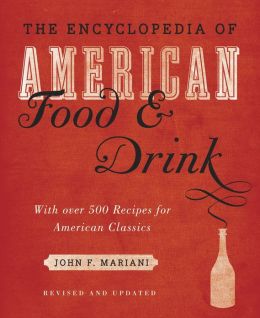 |
The Encyclopedia of American Food and Drink by John F. Mariani (Bloomsbury USA, $35) Modesty forbids me to praise my own new book, but let me proudly say that it is an extensive revision of the 4th edition that appeared more than a decade ago, before locavores, molecular cuisine, modernist cuisine, the Food Network and so much more, now included. Word origins have been completely updated, as have per capita consumption and production stats. Most important, for the first time since publication in the 1980s, the book includes more than 100 biographies of Americans who have changed the way we cook, eat and drink -- from Fannie Farmer and Julia Child to Robert Mondavi and Thomas Keller. "This book is amazing! It has entries for everything from `abalone' to `zwieback,' plus more than 500 recipes for classic American dishes and drinks."--Devra First, The Boston Globe. "Much needed in any kitchen library."--Bon Appetit. |
"Eating Italian will never be the same after reading John Mariani's entertaining and savory gastronomical history of the cuisine of Italy and how it won over appetites worldwide. . . . This book is such a tasteful narrative that it will literally make you hungry for Italian food and arouse your appetite for gastronomical history."--Don Oldenburg, USA Today. "Italian
restaurants--some good, some glitzy--far
outnumber their French rivals. Many of
these establishments are zestfully described
in How Italian Food Conquered the World, an
entertaining and fact-filled chronicle by
food-and-wine correspondent John F.
Mariani."--Aram Bakshian Jr., Wall Street
Journal.
"Equal parts
history, sociology, gastronomy, and just
plain fun, How Italian Food Conquered the
World tells the captivating and delicious
story of the (let's face it) everybody's
favorite cuisine with clarity, verve and
more than one surprise."--Colman Andrews,
editorial director of The Daily
Meal.com. "A fantastic and fascinating
read, covering everything from the influence
of Venice's spice trade to the impact of
Italian immigrants in America and the
evolution of alta cucina. This book will
serve as a terrific resource to anyone
interested in the real story of Italian
food."--Mary Ann Esposito, host of PBS-TV's
Ciao
Italia. "John Mariani has written the
definitive history of how Italians won their
way into our hearts, minds, and
stomachs. It's a story of pleasure over
pomp and taste over technique."--Danny Meyer,
owner of NYC restaurants Union Square
Cafe, The Modern, and Maialino.
|
 |
 |
 |
 |
 |
 |
 |
 |
 Everett Potter's Travel Report:
Everett Potter's Travel Report: 
 Eating Las Vegas
is the new on-line site for Virtual Gourmet
contributor John A. Curtas., who since 1995
has been commenting on the Las Vegas food
scene and reviewing restaurants for Nevada
Public Radio. He is also the
restaurant critic for KLAS TV, Channel 8 in
Las Vegas, and his past reviews can be
accessed at KNPR.org.
Click on the logo below to go directly to
his site.
Eating Las Vegas
is the new on-line site for Virtual Gourmet
contributor John A. Curtas., who since 1995
has been commenting on the Las Vegas food
scene and reviewing restaurants for Nevada
Public Radio. He is also the
restaurant critic for KLAS TV, Channel 8 in
Las Vegas, and his past reviews can be
accessed at KNPR.org.
Click on the logo below to go directly to
his site.

Tennis Resorts Online: A Critical Guide to the World's Best Tennis Resorts and Tennis Camps, published by ROGER COX, who has spent more than two decades writing about tennis travel, including a 17-year stretch for Tennis magazine. He has also written for Arthur Frommer's Budget Travel, New York Magazine, Travel & Leisure, Esquire, Money, USTA Magazine, Men's Journal, and The Robb Report. He has authored two books-The World's Best Tennis Vacations (Stephen Greene Press/Viking Penguin, 1990) and The Best Places to Stay in the Rockies (Houghton Mifflin, 1992 & 1994), and the Melbourne (Australia) chapter to the Wall Street Journal Business Guide to Cities of the Pacific Rim (Fodor's Travel Guides, 1991).


MARIANI'S VIRTUAL GOURMET
NEWSLETTER is published weekly. Editor/Publisher: John
Mariani.
Editor: Walter Bagley. Contributing Writers: Christopher Mariani,
Robert Mariani, John A.
Curtas, Edward Brivio, Mort Hochstein, Suzanne
Wright, and Brian Freedman. Contributing
Photographers: Galina Stepanoff-Dargery,
Bobby Pirillo. Technical Advisor: Gerry McLoughlin.
© copyright John Mariani 2014
